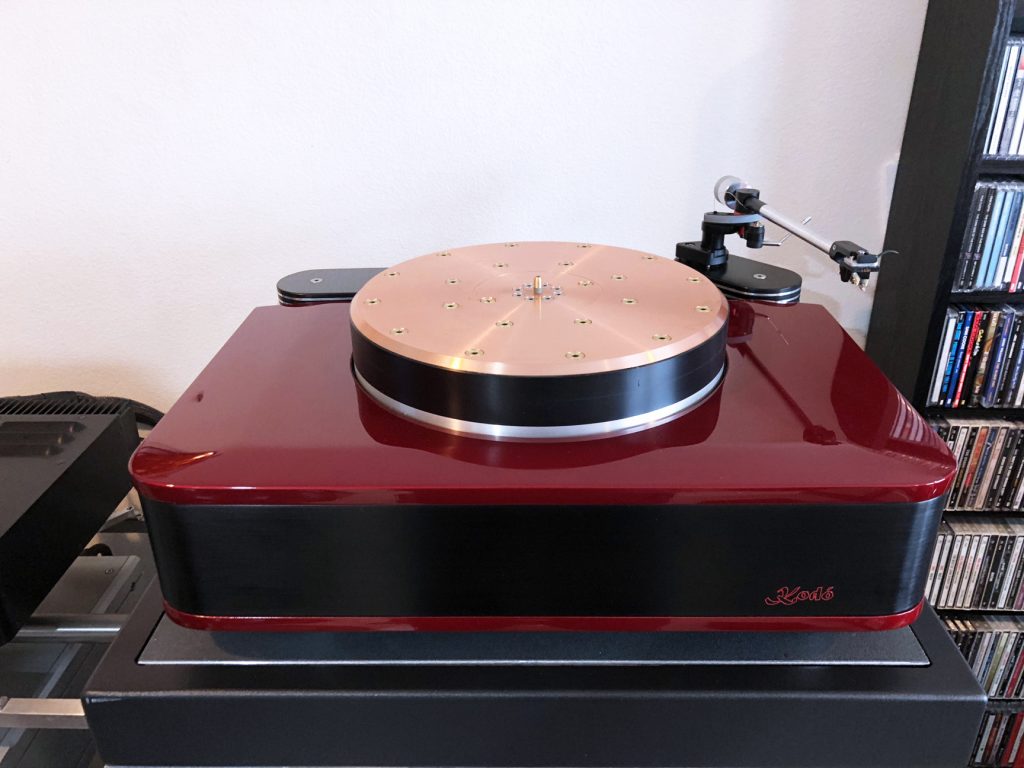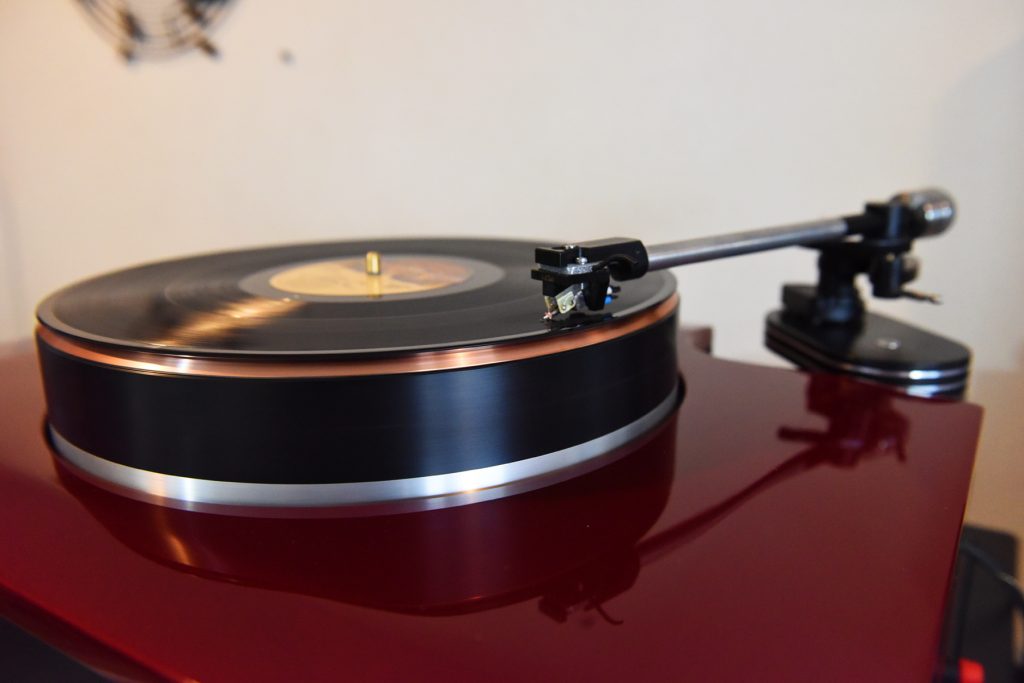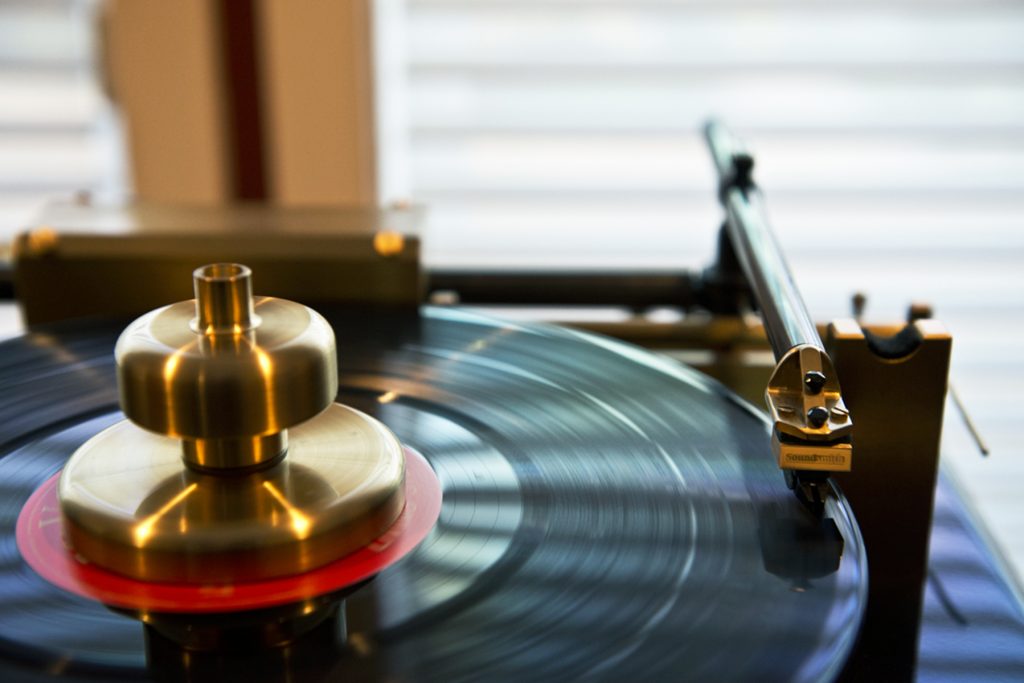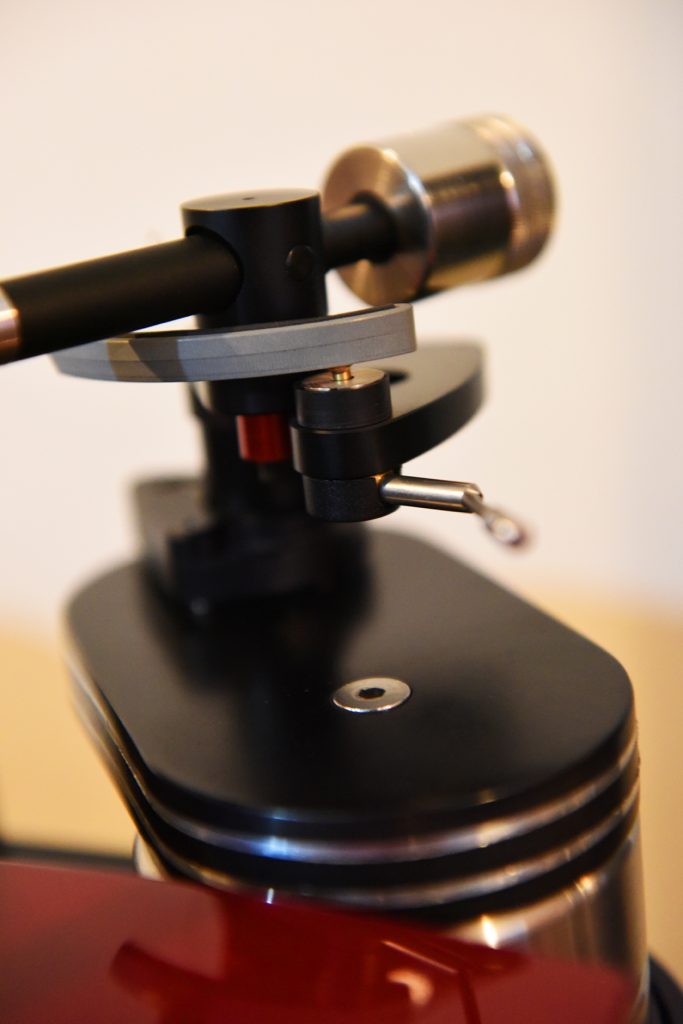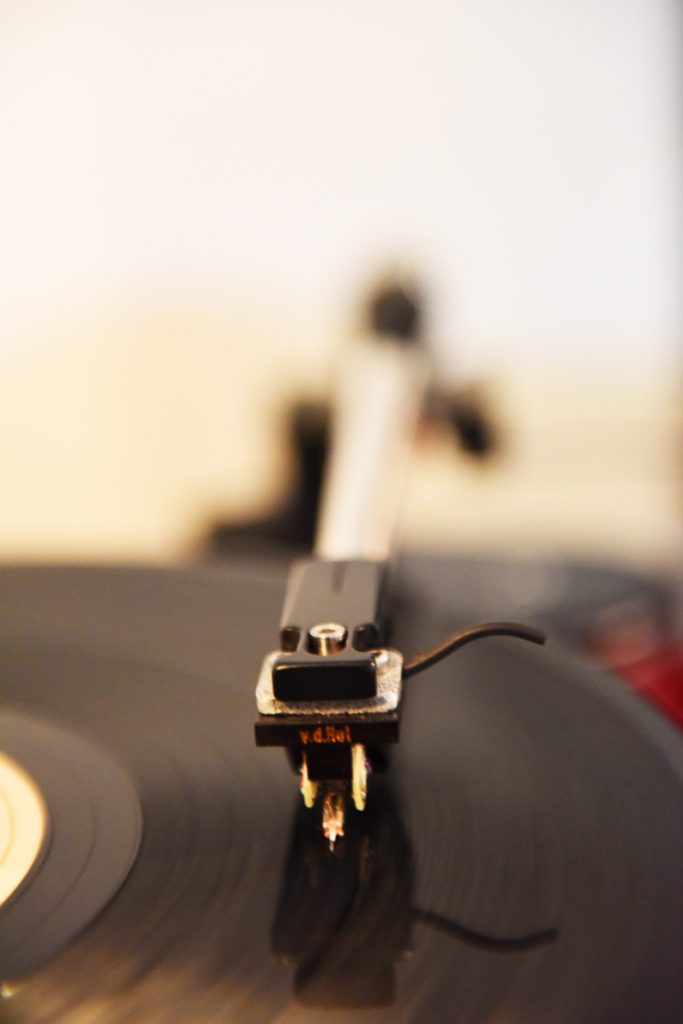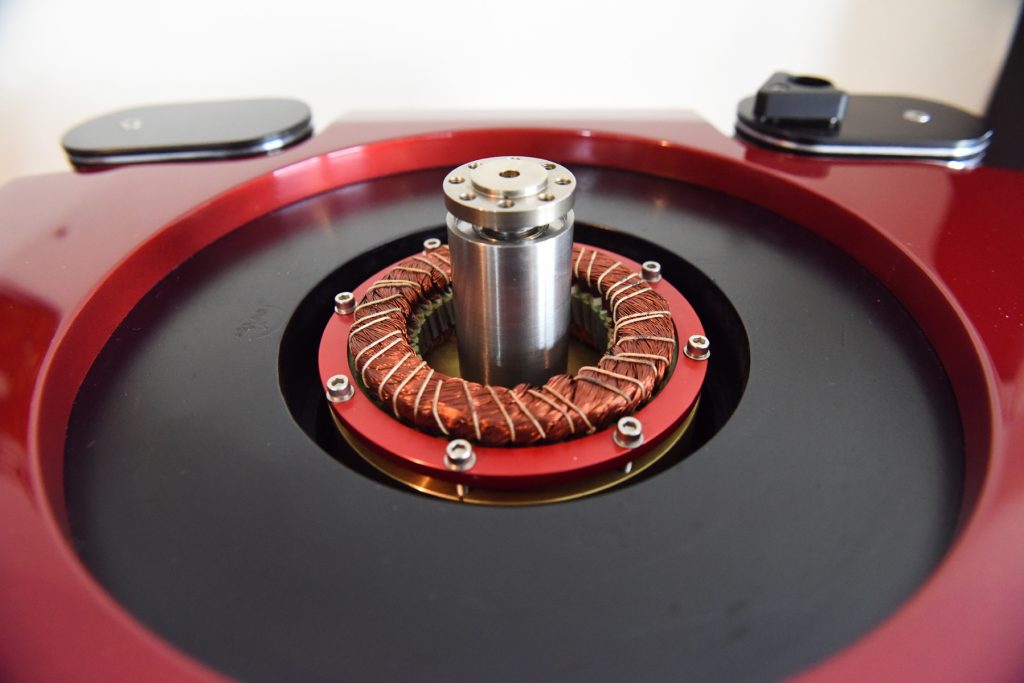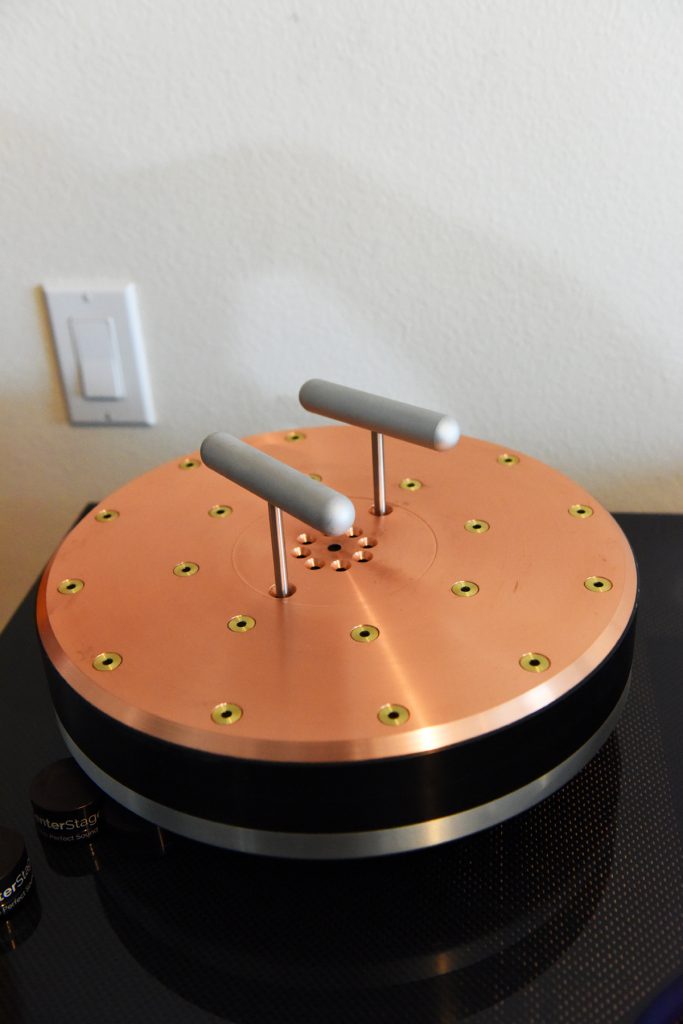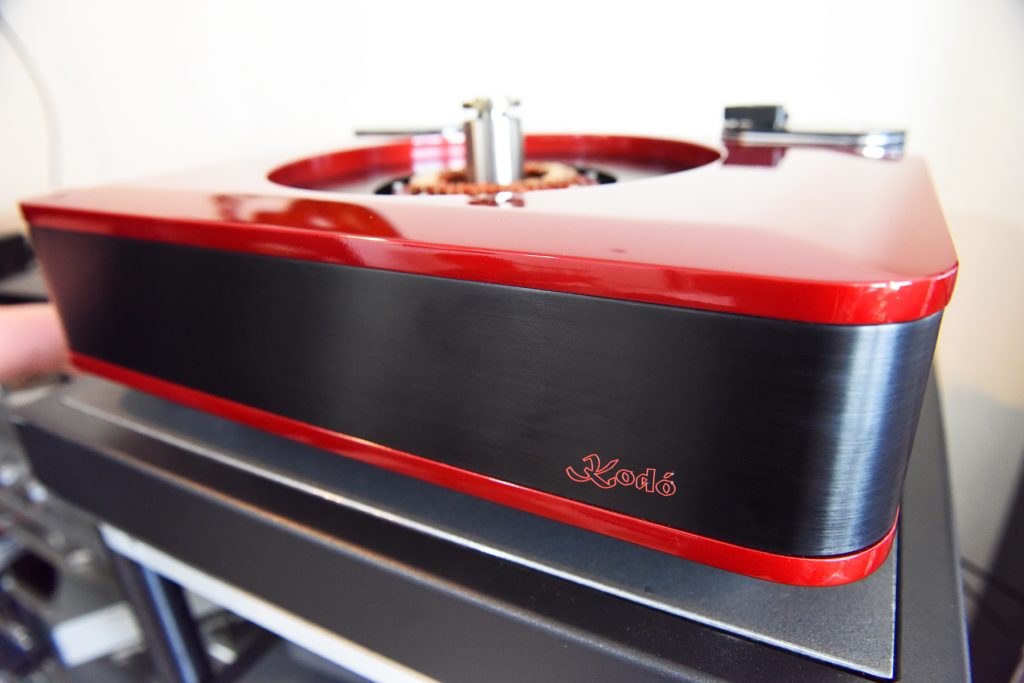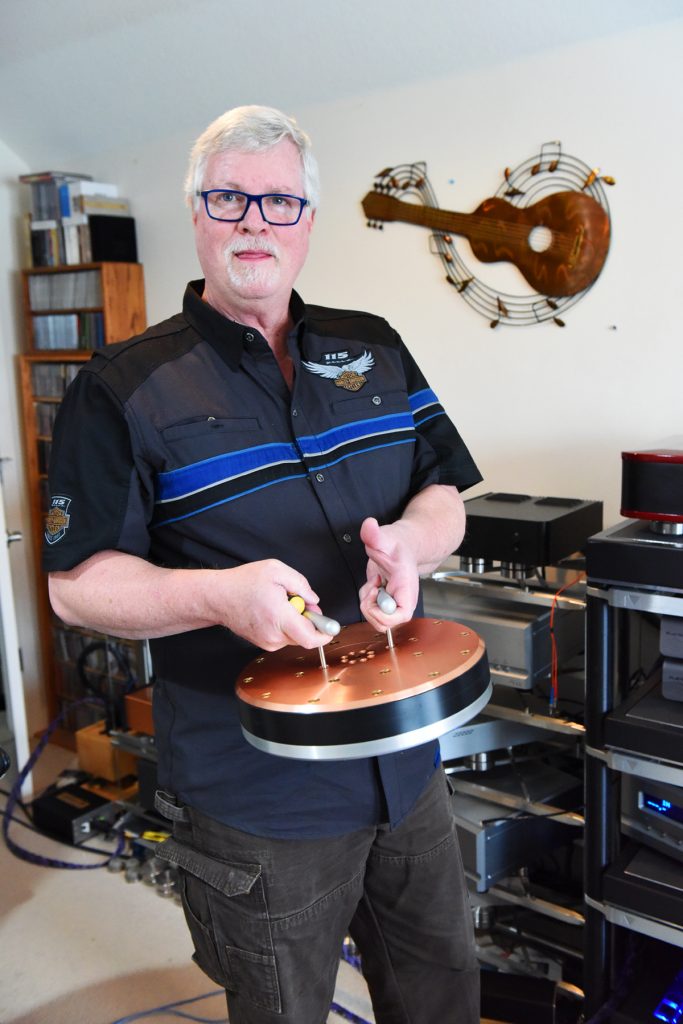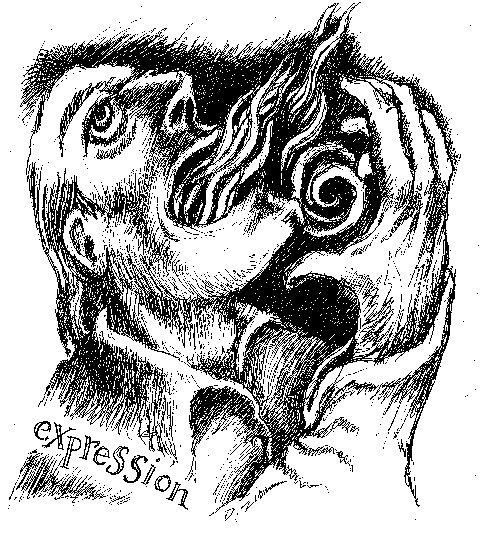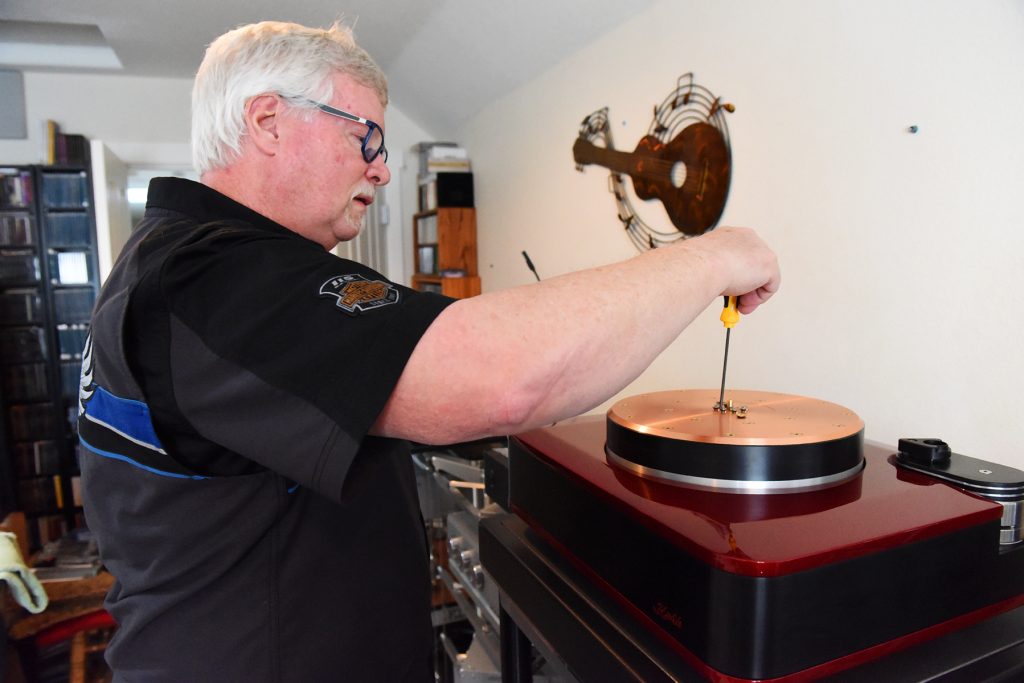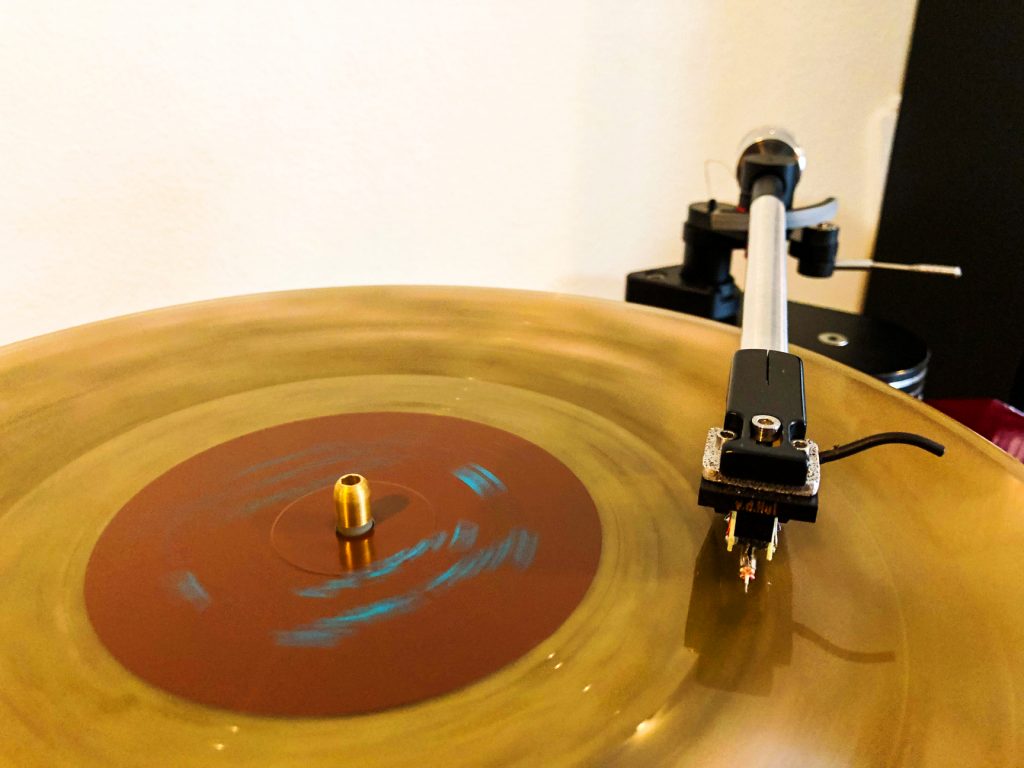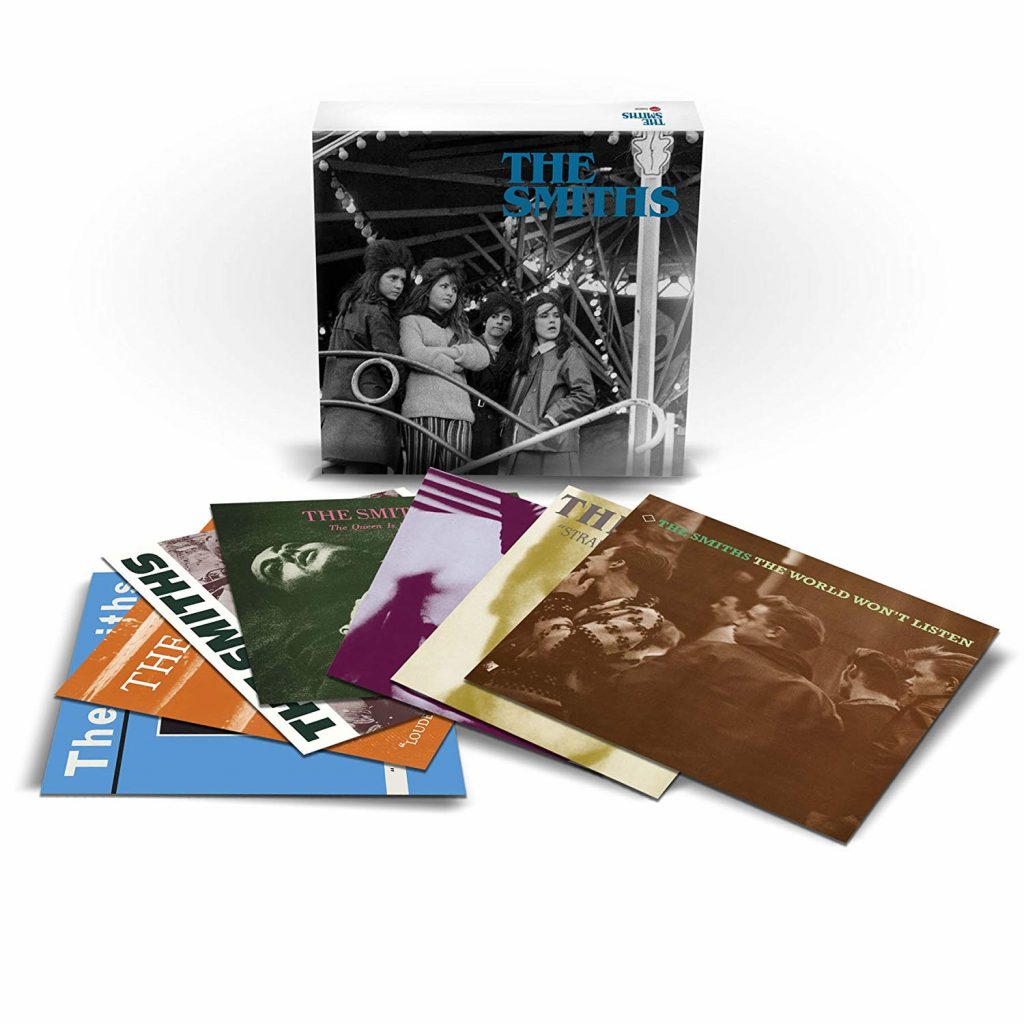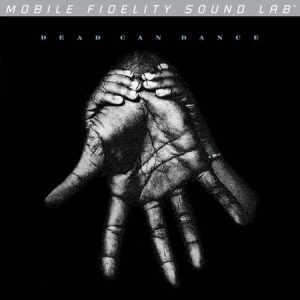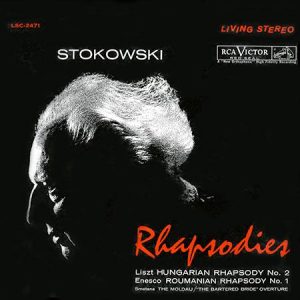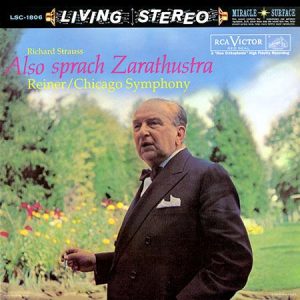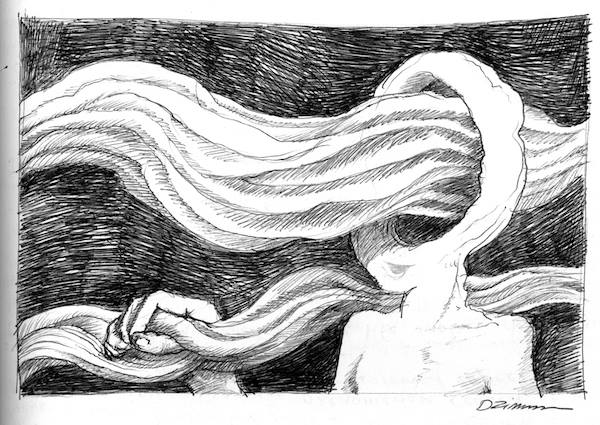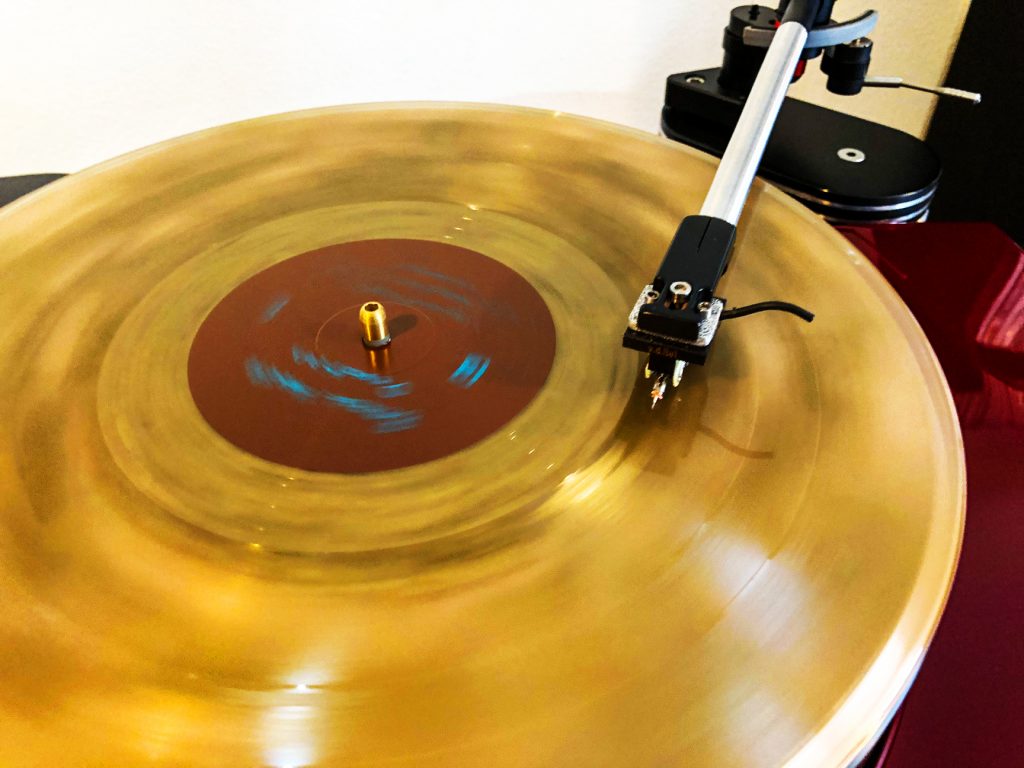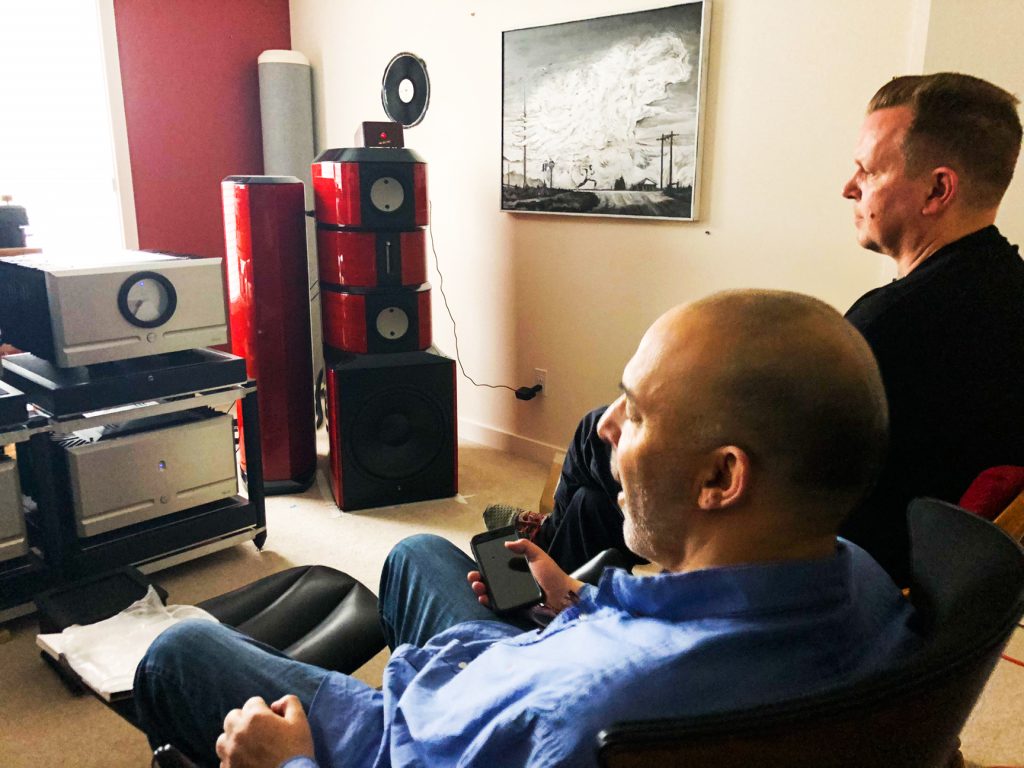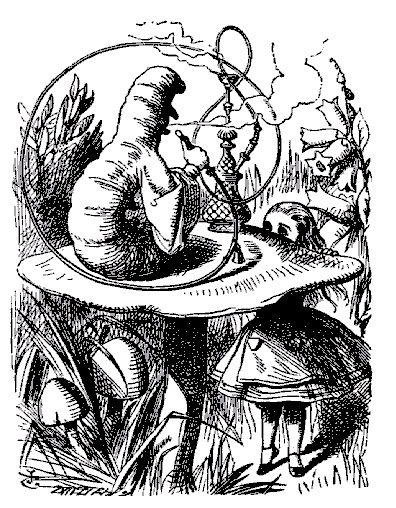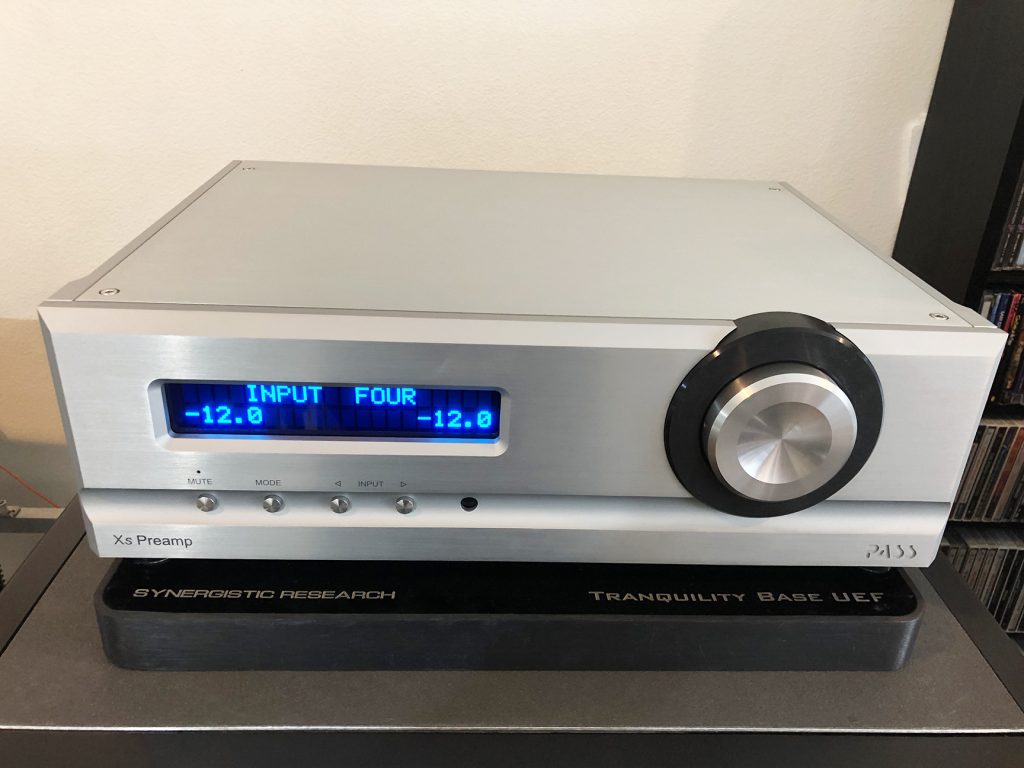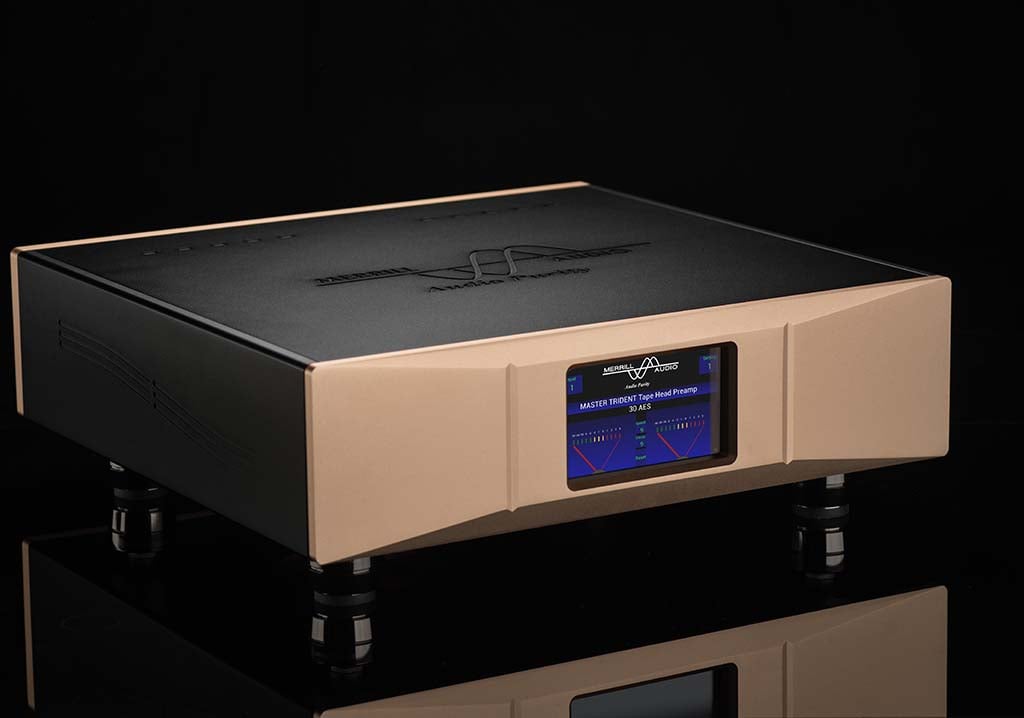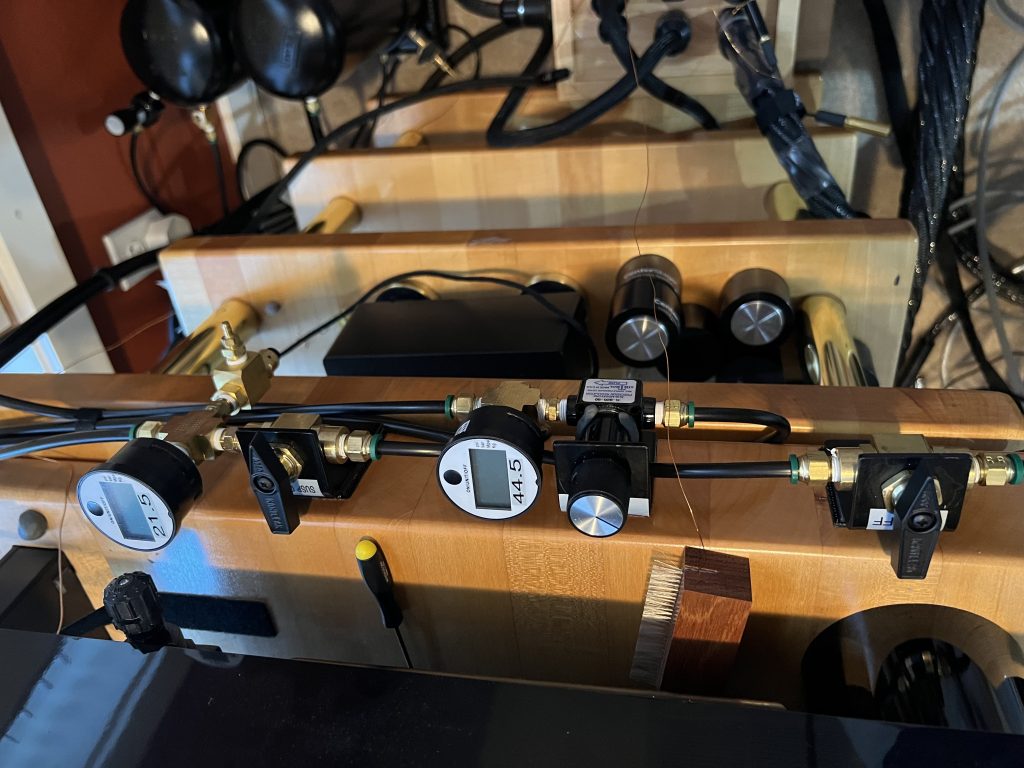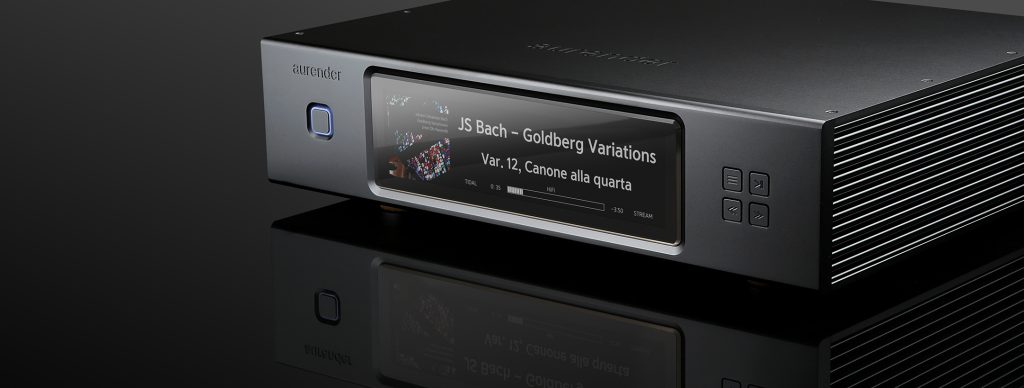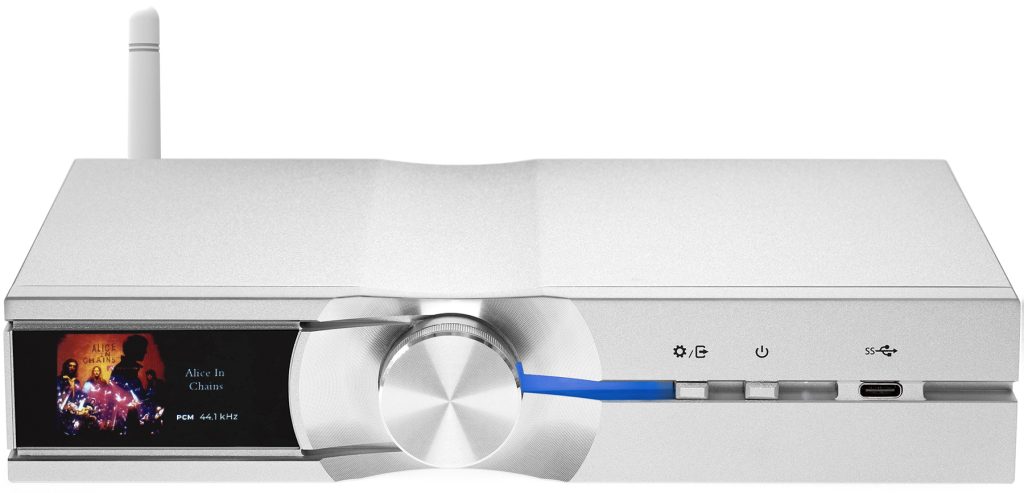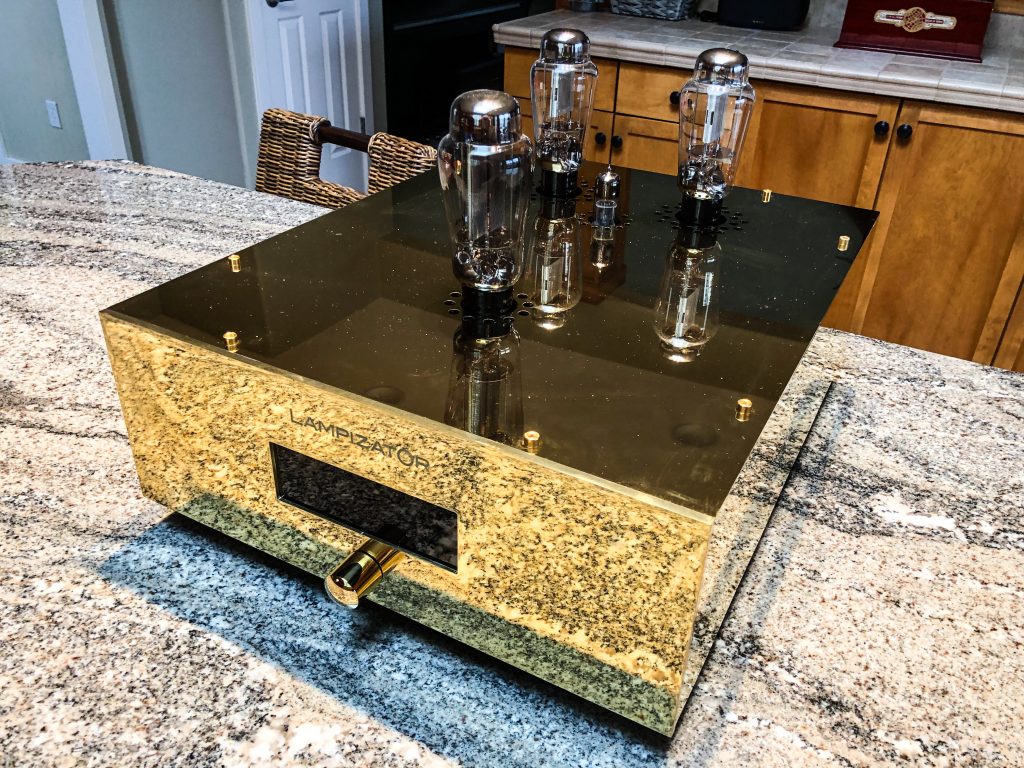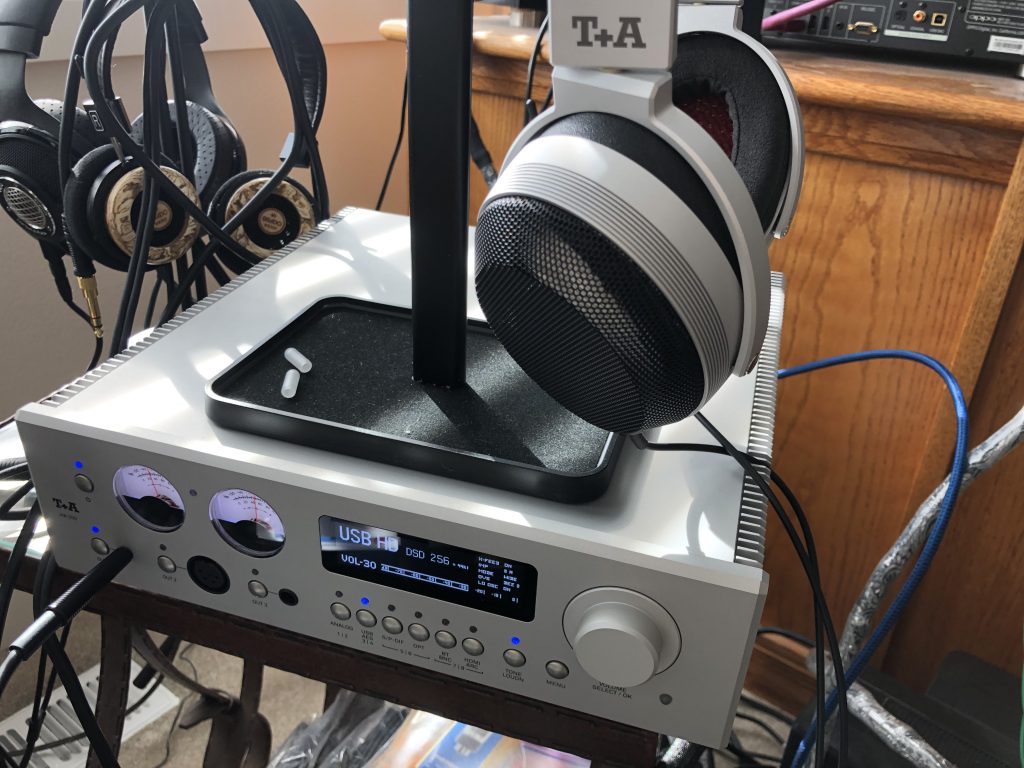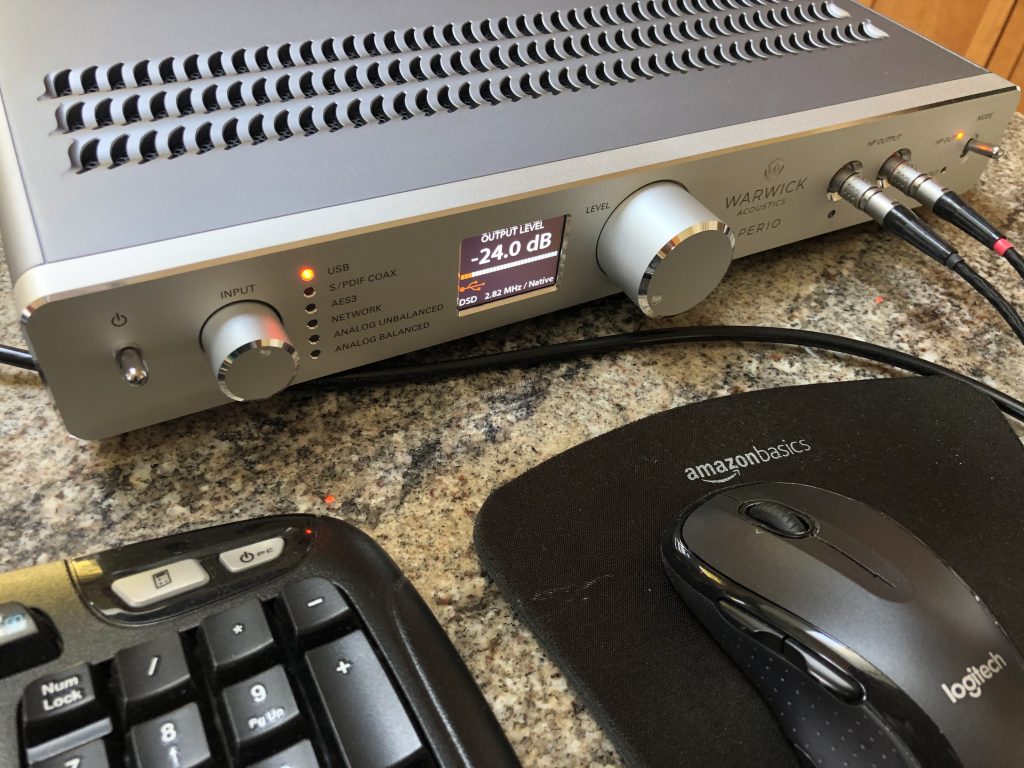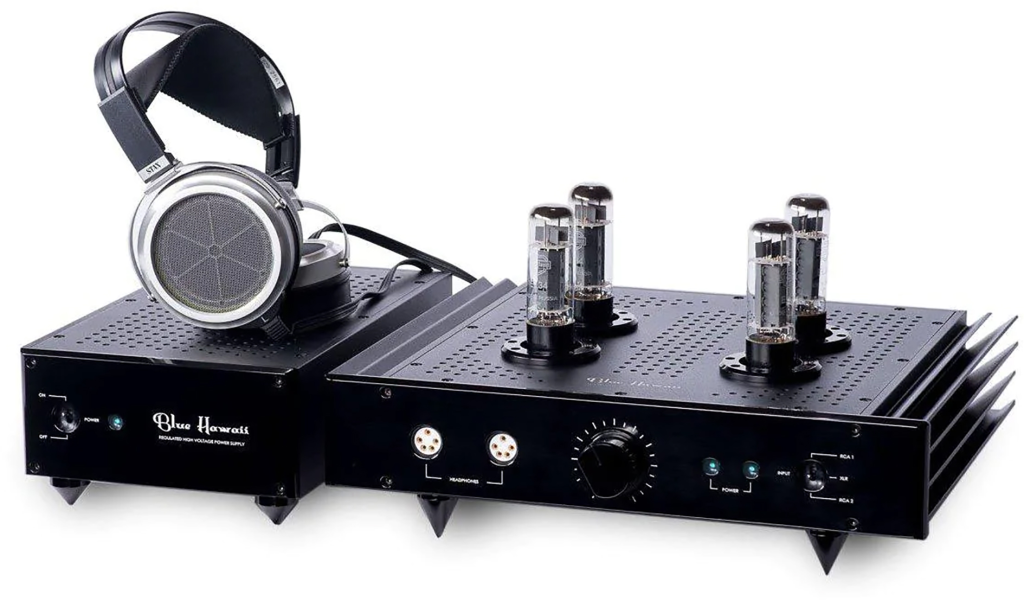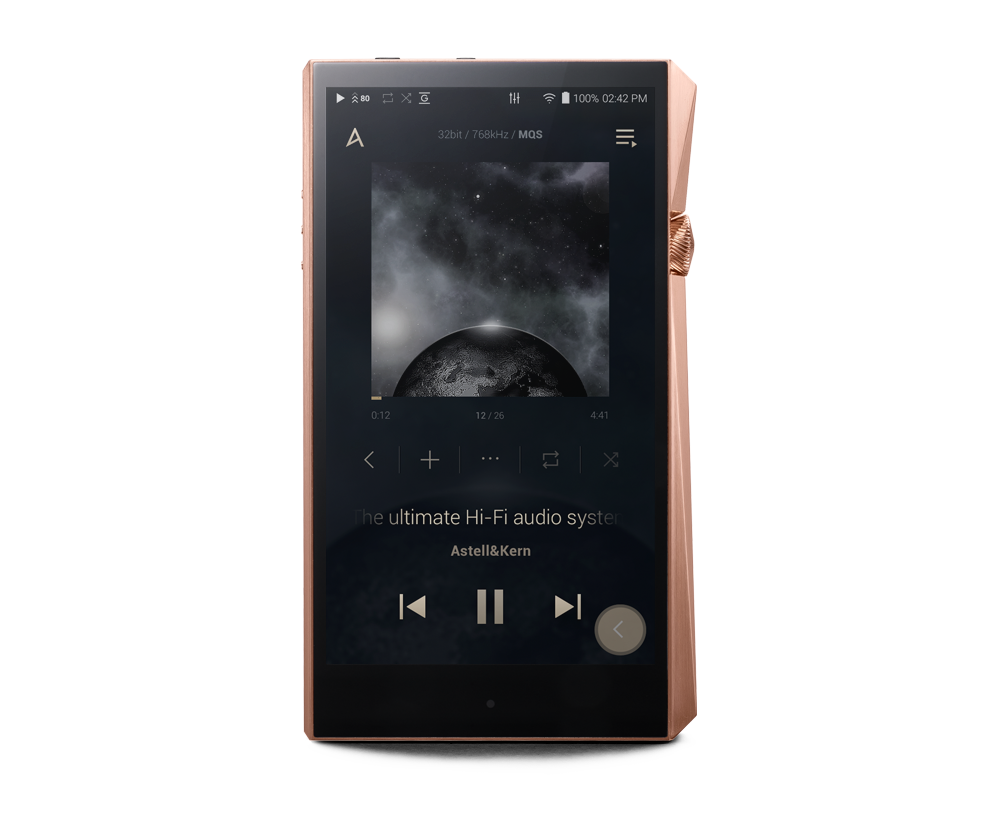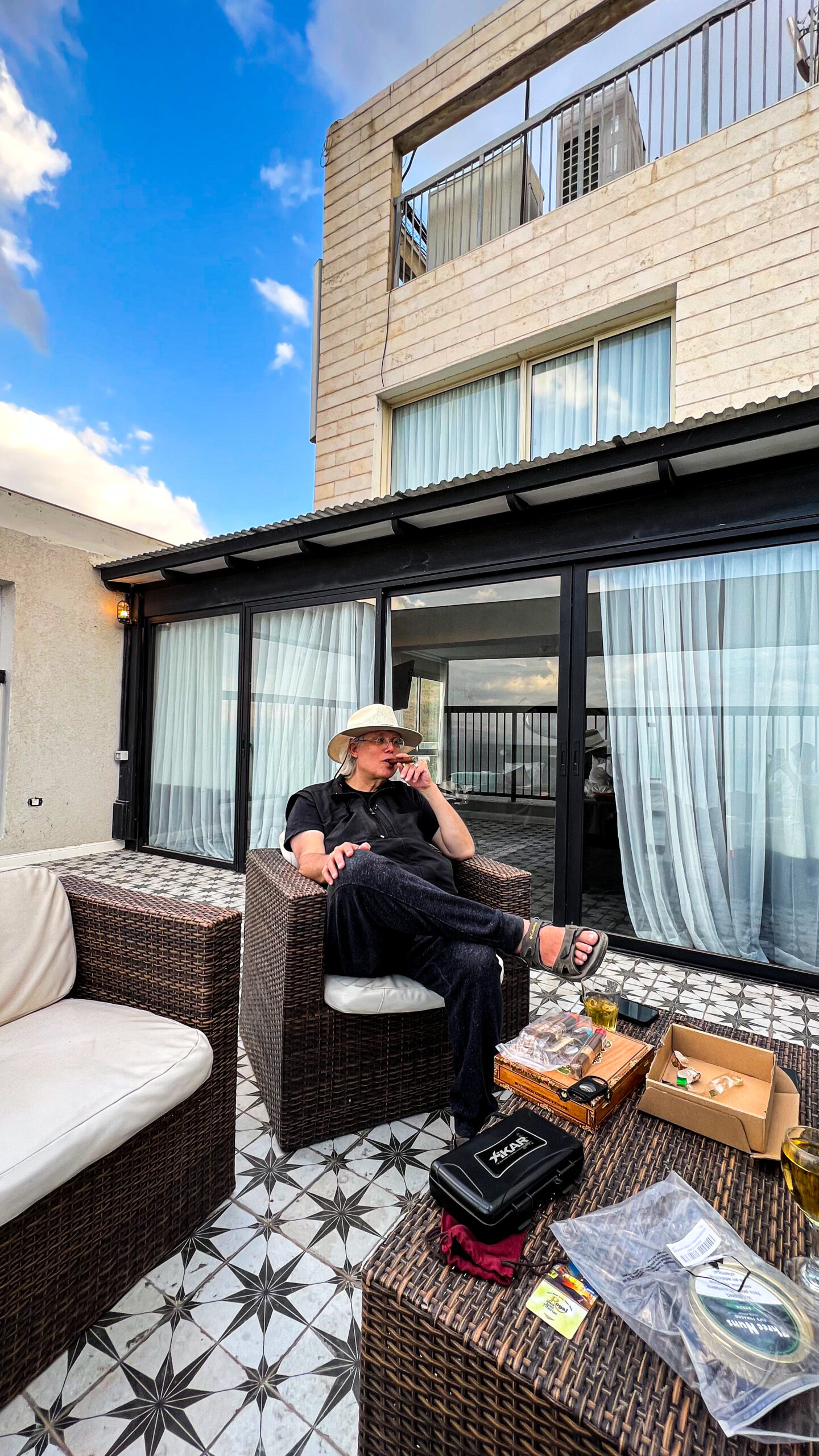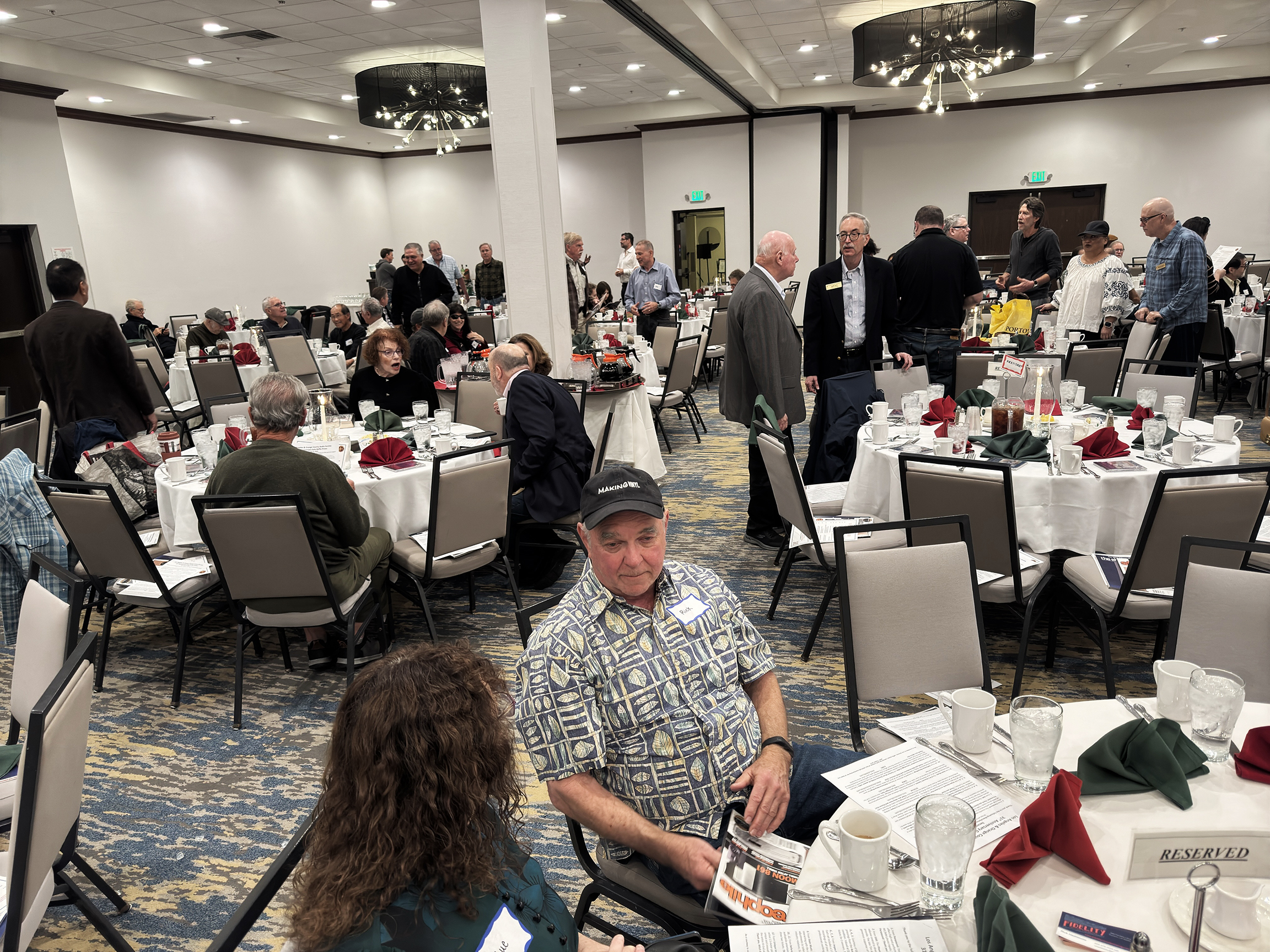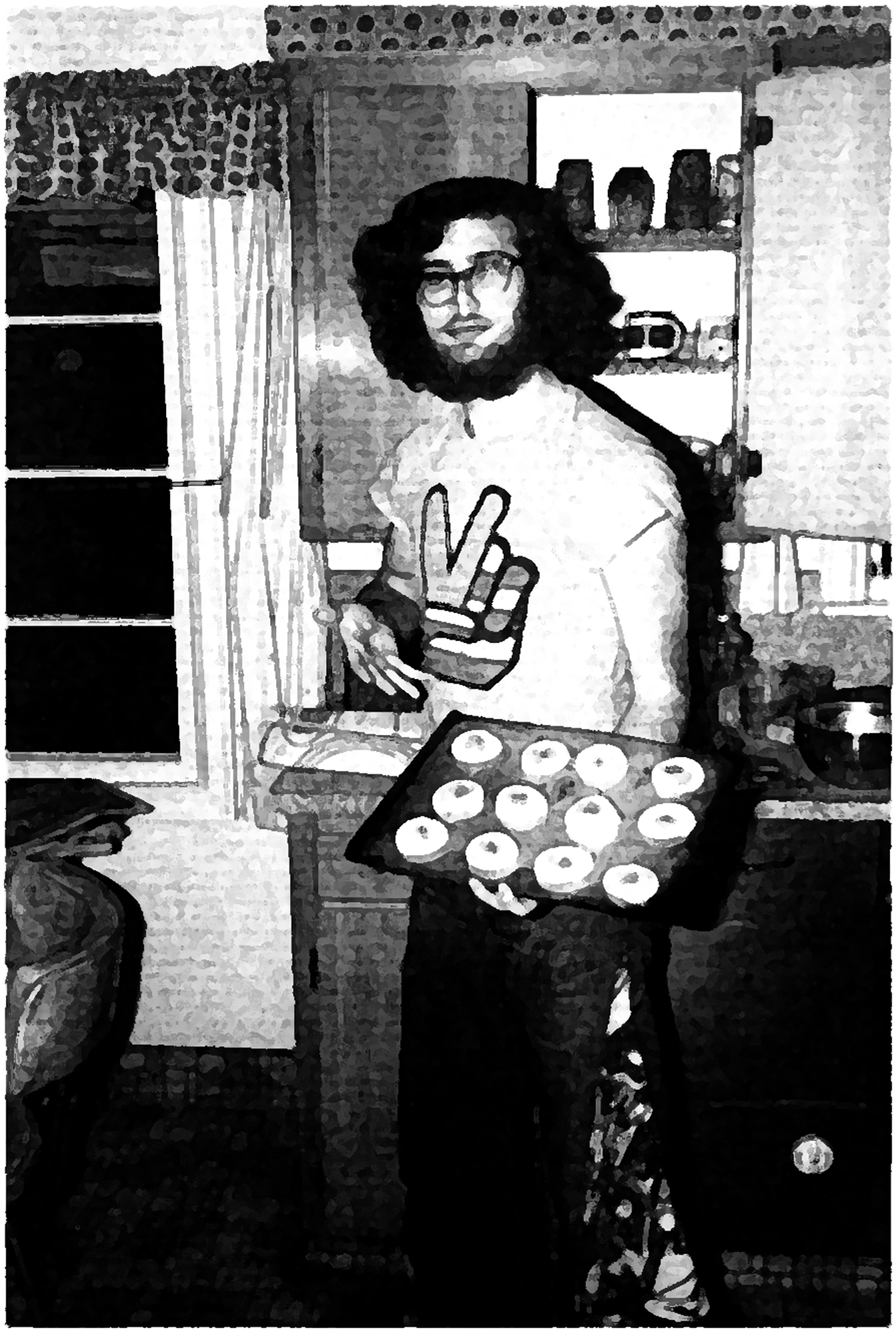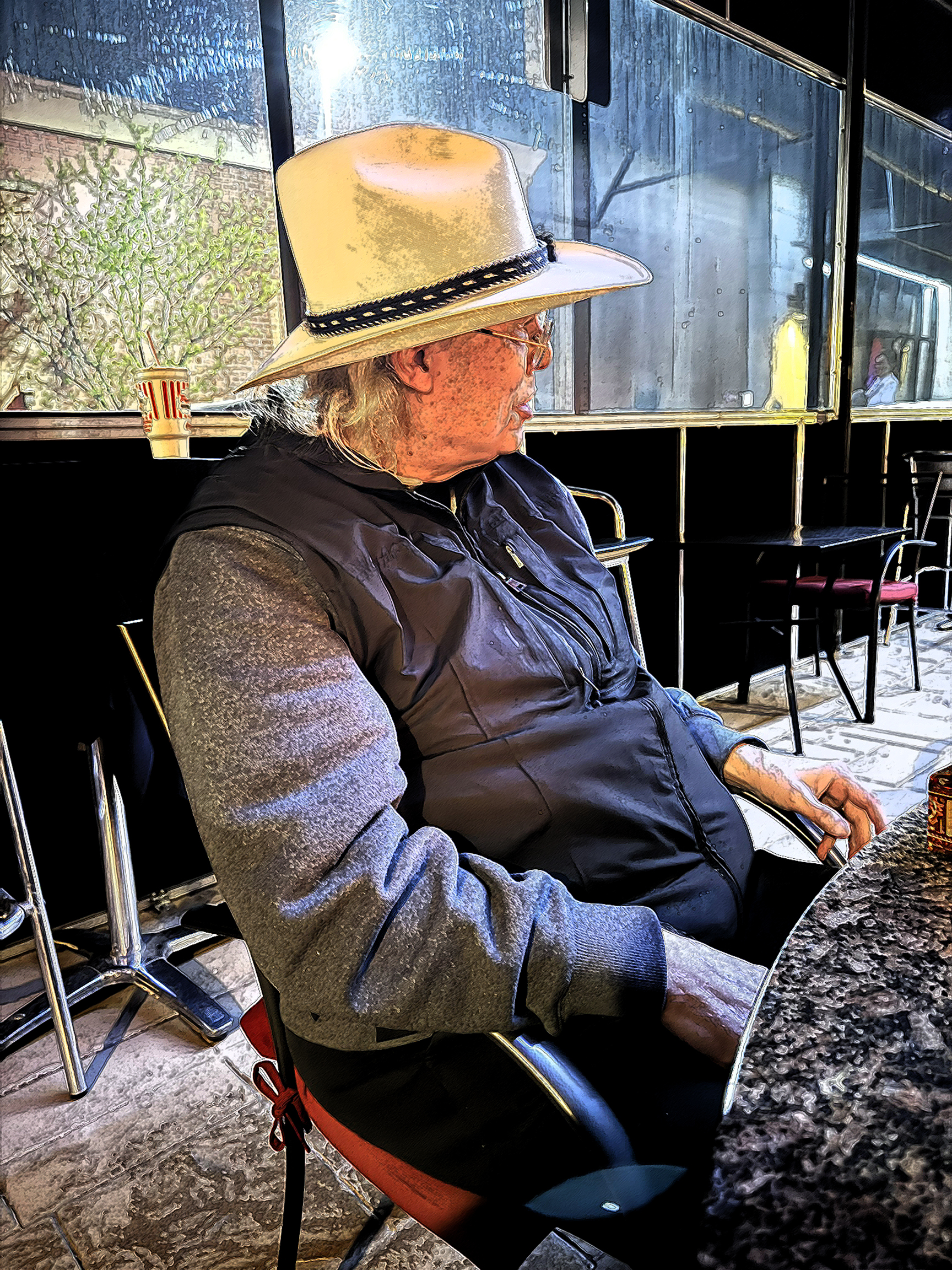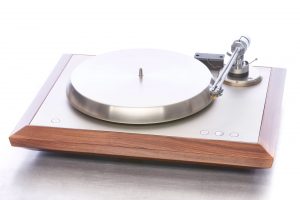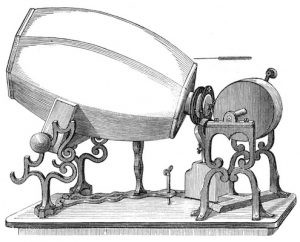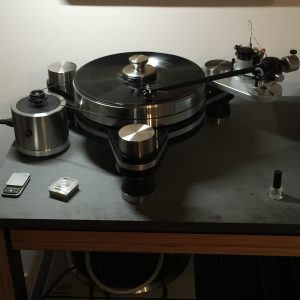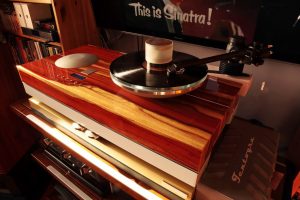The Beat MagDrive™ Turntable with Schröder Linear-Tracking (LT) Tonearm
Ye Olde Editor, in medias puffus (photograph by John Robinson)
Me, I call it "Big Red."
Here was a real mountaintop moment for me with turntables earlier this year. It came in two parts: First, getting to meet Steve Dobbins, the creative master turntable craftsman at Xact Audio, and his wife Polly. Steve is a master audio artisan who specializes in turntable and tonearm design and construction. His company is Xact Audio, headquartered right here in the Pacific Northwest, in Boise, Idaho. His proximity to Positive Feedback in the Portland, Oregon vicinity, made it feasible for Steve and I to hook-up for this review project.
Second, getting a chance to spend several months with Steve's reference ‘table, his Kodo The Beat Turntable and Schröder LT (Linear Tracking) Tonearm.
But I'm getting ahead of myself. I hadn't heard of Steve Dobbins before. The point of contact for getting to meet Steve was my audiobud and audio distributor, Randy Forman, of Finest Fidelity. He carries the van den Hul line, Accustic Arts, and has connections like Steve Dobbins. While looking for reference-quality turntables, Randy connected to Steve Dobbins. Randy is the one who brought Steve and his "The Beat" direct-drive turntable to my attention during one of our phone conversations early this year.
This couldn't have come at a better moment. I had already been thinking about direct drive turntables being a major thread for me in 2018…Steve's "The Beat" sounded like just the ticket. And it was out of the Pacific NW, too; I've always had a weakness for fine audio gear from this neck of the woods.
The other major turntable checkbox was to look at linear-tracking uni-pivoted tonearms. No, really. I had several on my list of possibilities, but that didn't include the LT tonearm that "The Beat" direct-drive ‘table had as a bundle option with it: none other than the Schröder Linear Tracking arm.
Aha! Schröder! There was a blast from the past for me.
It had been years since I had first contacted the legendary Frank Schröder…back in the early 2000s. At the time, I had been contemplating a review of the Galibier or Redpoint turntable, and was looking to pair one or the other with a suitable recommended tonearm by one or the other manufacturer. Frank, who is in Germany, and I corresponded via email, and attempted to line up the logistical schedule, but he was so busy with production that he kept falling behind. He and I finally had to give up the project reluctantly, and the whole thing was cancelled.
I knew that Frank was still quite active, however, since my connection with the brilliant soundsmith of Soundsmith, Peter Ledermann, talked to me about their link-up during Peter's development of the incredible Hyperion MI cartridge. (The Hyperion MI is my current pick for our reference Walker Audio Proscenium Level V turntable system. It's mind-blowing, truly.)
As it turns out, Steve Dobbins knows Frank Schröder too, and worked with him to develop a linear-tracking tonearm for his Kodo "The Beat" turntable. The most sophisticated linear-tracking tonearms feature a linear bar or guide that allows for the maintenance of a proper perpendicular tracking in the groove. This allows a cartridge to play back a groove in the same way that the cutting lathe did in mastering a LP, which is a huge geometric advantage. (By the way, if you are unfamiliar with the in's and out's of tonearm designs, you can check HERE or HERE for starts.) Phono cartridges with traditional gimbal and unipivot tonearms all suffer from deviations from true perpendicularity with respect to the groove, since both are fixed in a single mounting point, and inscribe an arc over the course of playing an LP. Those deviations mean that the stylus in the groove is angled in its relationship to the groove, and is more or less "off" through most of its playback of an LP. Longer arms can ameliorate this effect to a certain degree, by reducing the angle inscribed by the tonearm, but they cannot completely eliminate the problem, which is one of pure geometry. And longer tonearms come with their own set of design challenges.
The Walker Audio Proscenium Black Diamond Level V pure linear-tracking system in operation; the cartridge is the Soundsmith Hyperion MI
For the best example of linear tracking that I know of personally, my Walker Proscenium Black Diamond Level V Turntable with its powerful and precise air bearing design has an extraordinarily sophisticated development of this theoretically-best approach to playing LPs. The results are absolutely amazing…absolutely linear tracking…and the Walker turntable remains at the top o' the heap of turntables that I've had in my listening room. It's also my personal reference. The main problem with this obviously superior approach is the cost of building it. Lloyd Walker's turntable is exceptionally precise and accurate, but is not inexpensive!
To get around the demanding requirements of linear-tracking designs, some tonearm artisans have taken to a hybrid system. They have chosen to go with a single mounting point, like a gimbal or unipivot design, but then they employ innovative new tonearm configurations to produce a linear (that is, perpendicular) relationship between the attached phono cartridge and the groove. It's an attempt to get a lower-cost, more traditional implementation, with potentially more turntable platforms being serviced, while gaining the obvious superiority of linear-tracking tonearms.
This is what Steve Dobbins has worked with Frank Schröder to produce: a linear tracking (LT) tonearm for The Beat.
A view of the rear of the LT tonearm: you can see the gray magnetic guide and the round black departure point for the beginning of the LP underneath it. Works great!
It's a fascinating design. It has a single point of connection to the mount, but above that are a pair of tonearm guide points: one for tracking the beginning of an LP, and the other for the end of the transit. Between is a magnetic "glide" that moves the cartridge in the direction that the groove is tracking, with minimal latency. So the headshell is rigidly mounted and facing forward without the offset of standard unipivot or gimbal tonearm designs.
The Schröder LT tonearm with the van den Hul Colibri Signature Stradivarius in place
It's an extremely clever design, not quite like anything else I've seen in the world of linear tracking tonearms. Frank Schöder provides a summary of the LT tonearm; to read his notes, please go HERE. Note that Steve Dobbins is doing more to enhance the LT tonearm; check with him at the contact info at the end of this essay to learn more.
The Kodo reference turntable
But the LT tonearm, while seductive, rests upon the solid-rock foundation of The Beat. This remarkable direct-drive turntable is really the heart (The Beat as in "heart-beat") of what Steve Dobbins is about.
Here's what Steve has to say about the challenges of designing and building a true reference direct-drive turntable on his site:
"Building a turntable that can turn a platter quietly, and at a constant speed seems like a simple task. After listening to many turntables, it is obvious that such is not the case. Most turntables merely average the selected speed. Keeping the platter spinning at the correct speed consistently is certainly a rare accomplishment. Eliminating drive slippage is next to impossible on one drive method and noise is a major issue on another drive topology. Cogging or motor pulsations are the bane of the third major form of turntable propulsion."
It's true that belt-driven, edge-driven, and ribbon-driven drive systems have challenges. Unless extreme care is taken…which always drives up the price, and which may hit diminishing returns quickly…the problems that Steve mentions are inescapable.
"After studying all the main drive systems for turntables and a few not so common, our conclusion was that a form of what is commonly referred to as direct drive offered by far the most potential advantages. A quiet, low RPM motor, very low air turbulence, and the least amount of moving parts, hence the least amount of drivetrain losses, which equals less noise."
I would agree with Steve, as I've noted. Direct drive has been the way to go, assuming that you could get sufficient linearity out of the turntable drive. Over decades, this has been a tricky proposition, with many designers opting to go to easier/cheaper alternatives. But Steve notes that what he has done with The Beat is not the usual sort of thing.
"In fact, what we call "direct drive" is anything but direct drive. We use the term MagDrive™, which is a much more accurate description. Of the three common drive systems in use today, MagDrive™ is the only drive where there is no direct mechanical contact between the motor and the platter. There is only a magnetic field between the stator and the rotor. In other words more of the power going into the table is used to drive the platter and there will be less extraneous energy floating around that needs to be contained. No belt stiction, no idler wheel compression and no belt slippage. When one understands that the cartridge is really just measuring the size of the grooves in the record and how small these grooves are, we understand why maintaining speed and isolating outside vibrations from the record is of the utmost importance. The smallest variation in speed or external vibrational energy from the drive system will impart itself as a loss in clarity or distortion of the music. This is easily heard on sustained piano notes and female vocals."
The very heavy-duty motor and spindle of The Beat…beefy!
You can see the layers of different materials in The Beat's platter. Note that the spindle does not go all the way through the platter; the upper spindle is completely decoupled from the lower drive shaft, with a sandwich of isolating material in between.
Steve then goes on to discuss the nature of the motor that he uses on The Beat. He rejected single-pole AC motors (pulses lead to uneven performance); DC motors were also refused due to their lagging and variable performance under the load of turntable operation. Attempts to get around belt cogging through the use of massive platters were insufficient, he believes, since he thinks that such mass leads to LP playback that is "slow and lethargic." Thus Steve decided to go instead with a massive three-pole AC motor with a powerfully regulated power supply.
"What makes this motor the best choice for a turntable is that its speed is not affected by load changes such as stylus drag and bearing oil temperature. When the load changes, such as stylus drag (yes, it is real) in complex music passages and heavy bass lines, a synchronous motor instantly draws more current and supplies more torque to the platter. This makes the controversial matter of stylus drag a non-issue. Because of this behavior, this type of motor does not need any form of servo circuit to control the speed when fed the proper power.
This power is supplied via a sophisticated and very accurate power supply designed to give The Beat clean and consistent power with correct frequency, no matter how dirty your mains supply."
On top of that, Steve mentions an additional significant benefit of his motor/power supply design.
"This power supply also gives the audiophile another feature, adjustable motor torque. Every listener seems to enjoy a slightly different take on his music, so The Beat lets you adjust the torque of the drive system. Want more of a smooth sound? Dial the torque back and dynamics become softer. Want more impact and energy from your music? Turn up the torque and that leading edge energy from the kick drum, pluck of a string bass or piano becomes more intense. This is one area where the designers felt like allowing the listener control. The Beat lets you decide on the energy level and smoothness delivered from your vinyl source."
This is rather different; I don't remember seeing another direct drive that has this feature.
Steve Dobbins hoisting the hefty platter into place…
Overall, Steve's design is, in my experience, a unique combination of features. I was quite impressed with both the design philosophy, Steve's grasp of what's important in turntable construction, as well as the execution of all of this in the review sample that he loaned to me.
And this is what I spent several months with earlier this year.
General Specifications of The Beat LT
- LT Tonearm effective mass: 14-17 grams, depending on counterweight location
- Effective length: 282 mm
- No antiskate needed
- Zero tracking error when properly setup
- 21" wide
- 16" deep
- 7.5" tall with the integrated Stillpoints Ultra 5 Isolation Feet
- 102 pounds without tonearm
Separate power supply:
- 13 different torque settings
- 10.5" wide
- 11.2" deep
- 4.2" high
- Power supply and motor supports 120v or 230v, 50Hz or 60Hz
- Speeds: 33.3 and 45 RPM standard
- 78 rpm available on order
System Description
The system that I was listening to while The Beat LT was in place included the following:
- PASS Labs Xs reference system, including Xs Phono Amp, Xs Preamp, and a pair of Xs 150 dual-box monoblocks (150 watts per channel of pure Class A amplification)
- Evolution Acoustics MM2 Loudspeakers with EXACT external crossovers
- Cabling by Synergistic Research, Kubala-Sosna
- Racks by Critical Mass Systems and Stillpoints
- AC power distribution by Synergistic Research and Kubala-Sosna
- Active grounding by Synergistic Research
This is a very high-resolution setup, and in our listening room reveals any problems/shortcomings or virtues/superlatives quite effectively. We've had a pretty fair amount of reference gear though here. What would the current configuration reveal about The Beat LT as an approach to turntable design?
The Sound
The Beat LT was my first experience with linear tracking tonearms that were pivoted. Having been so very spoiled by the Walker Audio Proscenium Black Diamond Level V, I wasn't sure what the result would be.
No worries, though. None at all. Right from the start, The Beat LT just bloody made music, and did so in a way that brought the advantages of linear tracking to a more traditional platform. As I evaluated the audio virtues of this turntable over time, I noted the following observations:
Linearity – Well, yes, I guess that this would be obvious, but I still must mention that the power-supply-controlled design really did deliver the goods when it came to maintaining the smooth delivery of the grooves without any sense of variation or deviation from true speed. In my experience, only the very finest turntables can do this, often at the cost of mass and space/great complexity. Steve Dobbins' design keeps the footprint tight, and the layout deceptively simple. Linearity without pain…a really impressive achievement.
Clearly a turntable can be directly driven and controlled with a properly executed power supply, and a potent 3-pole AC motor, so powered, can get the job done wonderfully well.
Clarity and transparency… – Longtime readers of my audio reviews know the very high value that I place on transparency. This is the ability of an audio component/system to get out of the way of the music, to disappear and allow the grooves to speak as directly and cleanly as possible. For this to happen, noise and spurious sound must be rejected to the highest degree possible; vibration and echoes must be minimized.
The Beat LT does this extremely well. I see the foundation for this result in the MagDrive™ system at the heart of delivering spin to the platter, as well as in the layered and decoupled composition of Steve's striking design. Since the spindle is not a continuation of the underlying drive mechanism, the spindle and top layer of the platter floats on the isolating middle layer, and the discontinuity allows the LP to be driven without the addition of unnecessary vibration.
"Look ma! No clamp!"
Interestingly enough, when I asked Steve about using a record weight or clamp, he said that he didn't recommend them on The Beat LT. He believes that they aren't necessary, given the strengths of his MagDrive™ and the composition of the platter. (When I posted his position on the PF Facebook page, I got a bit of push-back from one reader, who pooh-poohed the idea of playing LPs without a weight or clamp. Nonetheless, Steve is adamant on this point; such devices are redundant on his turntable, he says. Me, I always listen to the designer; he or she should know. And if they don't, they shouldn't be doing what they're doing, eh?) So, throughout the months that The Beat LT was here, I listened without weights or clamping. I didn't notice any problems, so I can't fault Steve for his position on the subject with his turntable.
No matter what I listened to…and I listened to a ton of LPs while The Beat LT was here…the transparency was remarkable. It felt like my albums were simply floating in space, decoupled from the mechanics of spin science. And when your LPs are floating, so are you.
Did I mention that I love The Smiths?
And that their complete box set was bloody spot-on with The Beat LT/vdH CSS?
Now you know it.
Sun Kil Moon, Admiral Fell Promises on limited edition black vinyl
…and the resultant detail, texture, and timbre – No doubt here: Gobs of gob-smacking sonic tactility. When a turntable can take a lovely and touching album like Sun Kil Moon's Admiral Fell Promises and render it with such breathtaking, heartbreaking soul…well….
All of the delicate aspects of the acoustic guitar are presented with nuanced grace. The attack and stroke of Mark Kozelek's fingers on the strings, the haunting quality of his voice, hypnotic and entrancing, the zone that he's in, somewhere among rap, alternative rock, folkishness, and prophetic poesis…it's all here. Sitting in the room with The Beat LT/vdH CSS in our system was to feel like Sun Kil Moon was there. Really there.
And silence…you get silence.
Not a dead zone. (Go to CDs for that.)
Silence.
Oh yeah. Enough said about that category.
Dynamics – Yikes! No problem here at all. The Beat LT excelled at dynamic swings. Even with extremely dynamic albums like my old friend the Analogue Productions reissue of the RCA Living Stereo recording of Scheherazade with Reiner and the CSO, The Beat LT/van den Hul Colibri Signature Stradivarius plowed through with aplomb…no issues at all. Certainly the excellency of the van den Hul cartridge came to the fore, sounding as good as I've heard it.
Plenty of kapow! here, never fear.
And here. This Dead Can Dance LP on Silver Label Mobile Fidelity is one of my long-running reference albums. (On SACD too.)
All of the usual suspects that were rounded up and routed through The Beat LT blew through the Gates of Dynamics with ease…no mistracking, no hassles, no gotchas.
Killer.
Soundstaging and imaging – In a word, brilliant. It was during this review that I had added the mind-altering van den Hul Extenders (see my review HERE). These had the effect of noticeably enhancing both the depth of the soundstage, and sharpening the detail and placement of imaging. (Note that this was on top of all other treatments in the room, including the Synergistic Research Atmosphere XL4 and HFTs.)
The vinylmeplease.com reissue of The Books The Lemon of Pink was strangely tactile, despite its obvious heavily massaged production values. (Thanks to Nelson Pass for introducing me to both the VinylMePlease record club and this album. I owe you, amigo!)
All of this allowed me to pinpoint this category with great confidence. With all stereo recordings, whether acoustically minimalistic or multi-track artistic constructs, The Beat LT with the van den Hul did a wonderful job of painting a sonic canvass that really brought the soul of a recording home to me. The depth of my listening room was really deep with this combination. Furthermore, the specificity of imaging was quite impressive, especially in reference albums like the RCA LS of Reiner/CSO of Respighi Pines/Fountains of Rome.
And, of course, one of my all-time references for this category, the RCA LS of Stokowski: Rhapsodies simply stretched from sea to shining sea, and went deeply into the street. It was immediately clear that The Beat LT with vdH cartridge was exceptional in this category. (Given the quality of this recording, you'll know within ten seconds what the quality of your playback system is.) For me, this took maybe five seconds.
Bingo! The Beat LT with the van den Hul Colibri Signature Stradivarius cartridge took its place in the front rank of exceptional turntables for soundstaging and imaging, without a doubt.
Oh yeah. Gershwin. Killer with Gershwin!
Harmonic integration – Frequency response…bass, midrange, upper range…how well did they come together?
Like deadheads at a Jerry Garcia concert, see? The vdH cartridge is the very best that I've heard from AJ and company, with well-balanced tonality across the entire spectrum. This isn't one of those cartridges that "excels in midrange liquidity" but tails off high and low. (Yes, there are cartridges like that.) No, we're talking true full-range presentation. It was obviously benefitting from the underlying The Beat turntable system and the LT arm, which was a solid crystal-clear platform.
Tonally, everything crossed the finish line at the same time, hand in hand. The killer VinylMePlease pressing of Beach House's Devotion sounded truly righteous: haunting, moody, introspective, and atmospheric. Really right on sound for this excellent album!
Uh, once again…you do belong to VinylMePlease, right? If not, and you love LPs, stop whatever you're doing and go to http://www.vinylmeplease.com/.
Just do it. You can thank me later.
Altogether, I didn't hear any areas in The Beat LT that lagged, after tons and tons of a diverse crop of LPs. No minuses to my ears…all pluses.
Gratifying! Righteous!
Final Thoughts
So, what's my final take on Steve Dobbins' The Beat LT with the van den Hul Colibri Signature Stradivarius?
I knew the sound of the vdH cartridge from prior extended listening with the classic pro direct-drive table, the EMT 948 (what a great turntable!), but this was my first project with the vdH CSS on a pivoted linear tracking tonearm and a completely different direct-drive system.
Jonathan Tinn of Blue Light Audio and Din Johnson of Ristretto Roasters digging the sound of The Beat LT with van den Hul CSS
This turntable system did what all really great turntables do for me: made me relax, loosen up, get into the music, and drift away. Once you get used to the handling of the action of the Schröder LT tonearm…just a bit of body English to be learned to cue it up…then it functioned smoothly and without hassle. In fact, it was a pleasure to use the Schröder LT. Its action was predictable, and cuing any track was easy. Certainly the vdH CSS cartridge was happy in this setting (and I've heard it in three different turntable/tonearm systems now). Excellent synergy; brilliant performance.
The reliability was absolute once the setup was complete. I didn't have any problems with turntable, tonearm, or cartridge during the months that they were together here.
It's definite in my mind and ears: The Beat LT with van den Hul Colibri Signature Stradivarius is a combination that belongs on my top-o'-the-heap list for turntable systems. The unit that I had was drop-dead gorgeous, and made beautiful music all day long, for months on end. Listening to it was wonderful, but I have to tell you: just looking at it was a treat!
Yes, this system is pricey...$57,895…but in my experience, all true reference-level turntable systems are costly. And you can certainly spend more than this number when shopping in this class. It's just the nature of the beast.
As with all truly great products, I admit that I was very sorry to see The Beat LT leave. Very.
You really hate to see the top-notch stuff go!
Which tells me: The Xact Audio The Beat LT turntable system with the van den Hul Colibri Signature Stradivarius cartridge earn a "Ye Olde Editor's ‘very highest recommendation,'" with pleasure and enthusiasm!
If you're in the market for the very best in turntable systems, you'll definitely want to check into this one.
Prices
The Beat SE: $45,900, which includes the Schröder LT tonearm as well personal setup anywhere in the USA; cartridge is an additional cost
van den Hul Colibri Signature Stradivarius MC cartridge: $11,995
Total system price, as reviewed: $57,895, delivered, setup, and training on site
Manufacturer and retailer
Xact Audio
http://xactaudio.com/contactus.php
208.860.9559
All photographs and image processing by David W. Robinson, unless otherwise noted. Cover images are fair-use from online sources. Cartoons by Dan Zimmerman; classic Alice in Wonderland cartoon by Sir John Tenniel, in the public domain.




